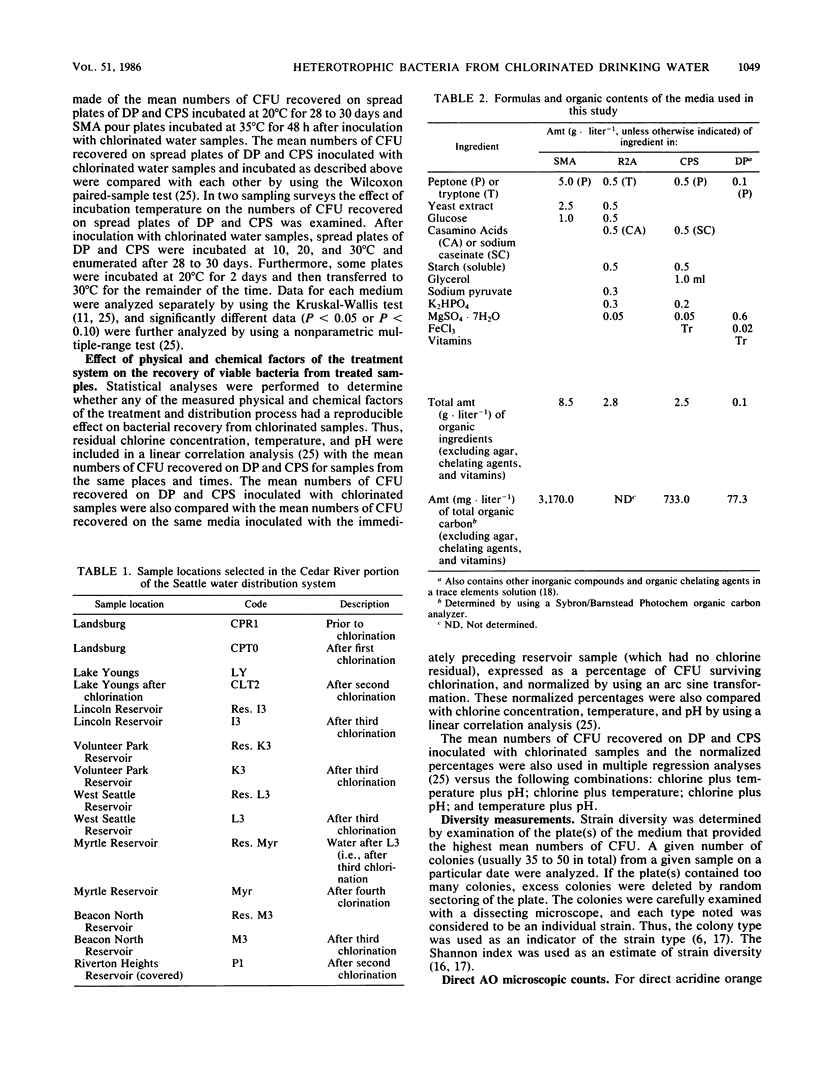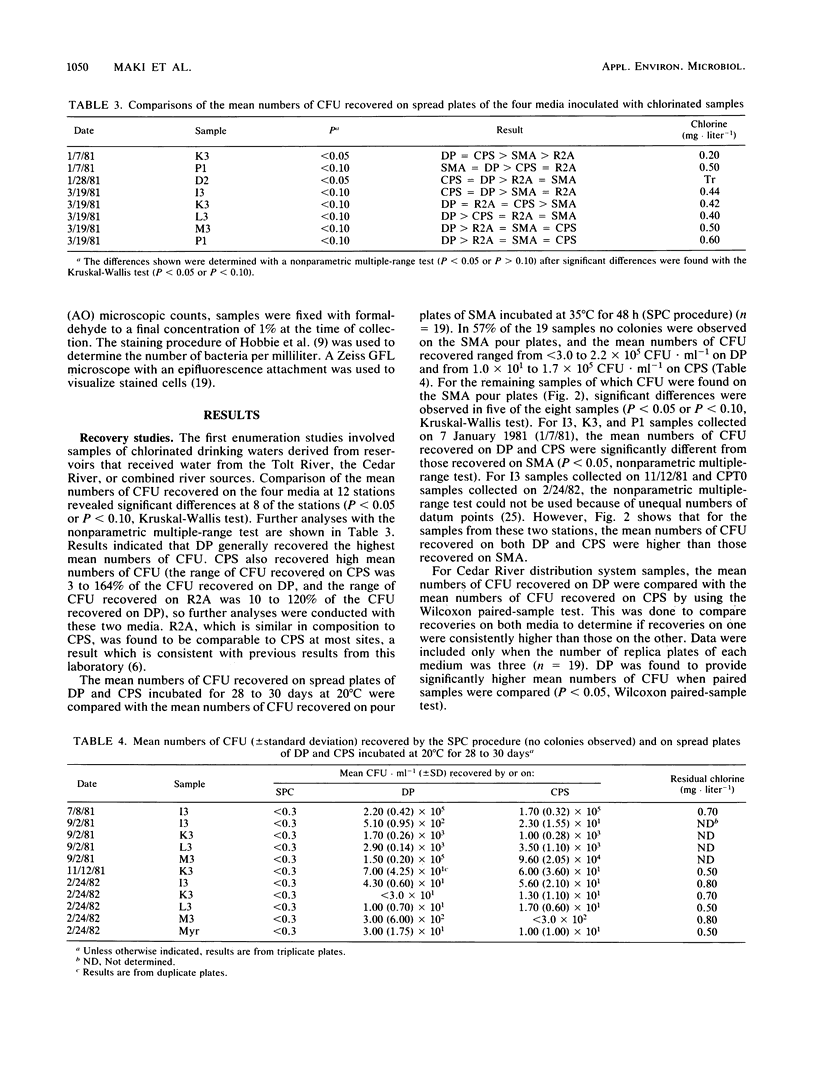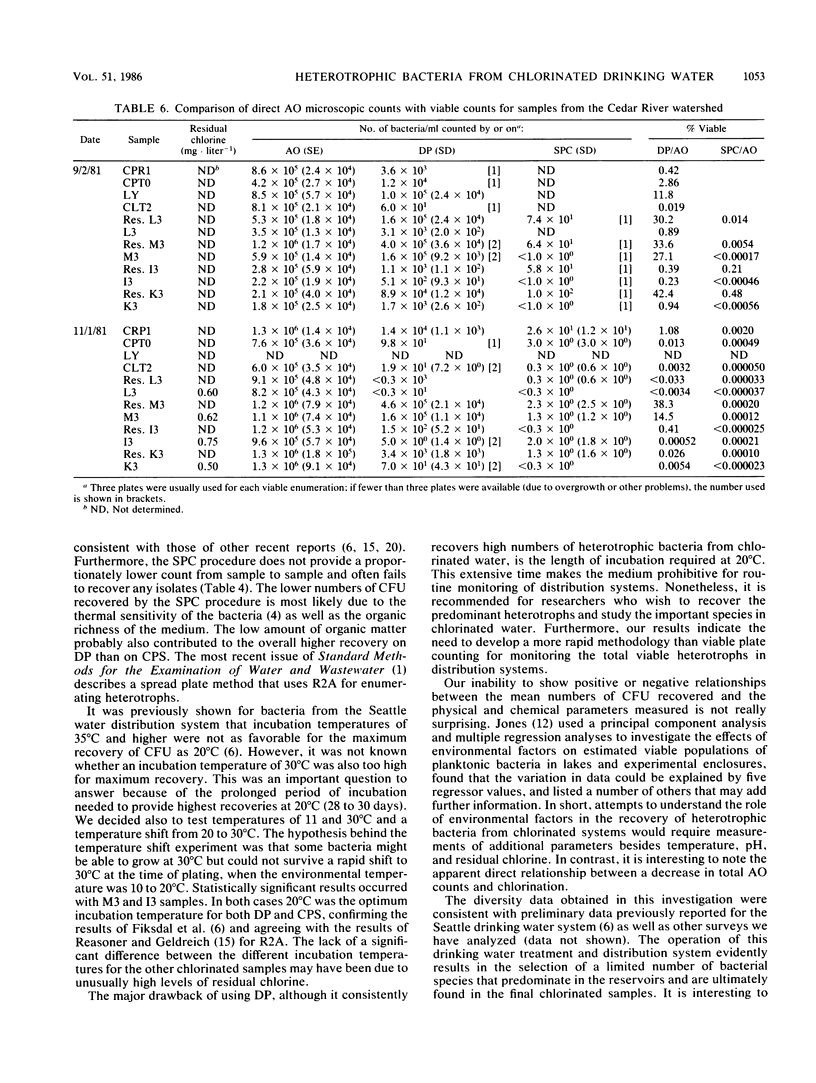Abstract
Heterotrophic bacteria were enumerated from the Seattle drinking water catchment basins and distribution system. The highest bacterial recoveries were obtained by using a very dilute medium containing 0.01% peptone as the primary carbon source. Other factors favoring high recovery were the use of incubation temperatures close to that of the habitat and an extended incubation (28 days or longer provided the highest counts). Total bacterial counts were determined by using acridine orange staining. With one exception, all acridine orange counts in chlorinated samples were lower than those in prechlorinated reservoir water, indicating that chlorination often reduces the number of acridine orange-detectable bacteria. Source waters had higher diversity index values than did samples examined following chlorination and storage in reservoirs. Shannon index values based upon colony morphology were in excess of 4.0 for prechlorinated source waters, whereas the values for final chlorinated tap waters were lower than 2.9. It is not known whether the reduction in diversity was due solely to chlorination or in part to other factors in the water treatment and distribution system. Based upon the results of this investigation, we provide a list of recommendations for changes in the procedures used for the enumeration of heterotrophic bacteria from drinking waters.
Full text
PDF








Images in this article
Selected References
These references are in PubMed. This may not be the complete list of references from this article.
- Armstrong J. L., Calomiris J. J., Seidler R. J. Selection of antibiotic-resistant standard plate count bacteria during water treatment. Appl Environ Microbiol. 1982 Aug;44(2):308–316. doi: 10.1128/aem.44.2.308-316.1982. [DOI] [PMC free article] [PubMed] [Google Scholar]
- Armstrong J. L., Shigeno D. S., Calomiris J. J., Seidler R. J. Antibiotic-resistant bacteria in drinking water. Appl Environ Microbiol. 1981 Aug;42(2):277–283. doi: 10.1128/aem.42.2.277-283.1981. [DOI] [PMC free article] [PubMed] [Google Scholar]
- Calomiris J. J., Armstrong J. L., Seidler R. J. Association of metal tolerance with multiple antibiotic resistance of bacteria isolated from drinking water. Appl Environ Microbiol. 1984 Jun;47(6):1238–1242. doi: 10.1128/aem.47.6.1238-1242.1984. [DOI] [PMC free article] [PubMed] [Google Scholar]
- Hobbie J. E., Daley R. J., Jasper S. Use of nuclepore filters for counting bacteria by fluorescence microscopy. Appl Environ Microbiol. 1977 May;33(5):1225–1228. doi: 10.1128/aem.33.5.1225-1228.1977. [DOI] [PMC free article] [PubMed] [Google Scholar]
- Jones J. G. Studies on freshwater bacteria: effect of medium composition and method on estimates of bacterial population. J Appl Bacteriol. 1970 Dec;33(4):679–686. doi: 10.1111/j.1365-2672.1970.tb02250.x. [DOI] [PubMed] [Google Scholar]
- Lamka K. G., LeChevallier M. W., Seidler R. J. Bacterial contamination of drinking water supplies in a modern rural neighborhood. Appl Environ Microbiol. 1980 Apr;39(4):734–738. doi: 10.1128/aem.39.4.734-738.1980. [DOI] [PMC free article] [PubMed] [Google Scholar]
- Reasoner D. J., Geldreich E. E. A new medium for the enumeration and subculture of bacteria from potable water. Appl Environ Microbiol. 1985 Jan;49(1):1–7. doi: 10.1128/aem.49.1.1-7.1985. [DOI] [PMC free article] [PubMed] [Google Scholar]
- Staley J. T., Lehmicke L. G., Palmer F. E., Peet R. W., Wissmar R. C. Impact of mount st. Helens eruption on bacteriology of lakes in the blast zone. Appl Environ Microbiol. 1982 Mar;43(3):664–670. doi: 10.1128/aem.43.3.664-670.1982. [DOI] [PMC free article] [PubMed] [Google Scholar]
- van der Kooij D., Oranje J. P., Hijnen W. A. Growth of Pseudomonas aeruginosa in tap water in relation to utilization of substrates at concentrations of a few micrograms per liter. Appl Environ Microbiol. 1982 Nov;44(5):1086–1095. doi: 10.1128/aem.44.5.1086-1095.1982. [DOI] [PMC free article] [PubMed] [Google Scholar]
- van der Kooij D., Visser A., Hijnen W. A. Growth of Aeromonas hydrophila at Low Concentrations of Substrates Added to Tap Water. Appl Environ Microbiol. 1980 Jun;39(6):1198–1204. doi: 10.1128/aem.39.6.1198-1204.1980. [DOI] [PMC free article] [PubMed] [Google Scholar]
- van der Kooij D., Visser A., Oranje J. P. Multiplication of fluorescent pseudomonads at low substrate concentrations in tap water. Antonie Van Leeuwenhoek. 1982;48(3):229–243. doi: 10.1007/BF00400383. [DOI] [PubMed] [Google Scholar]




